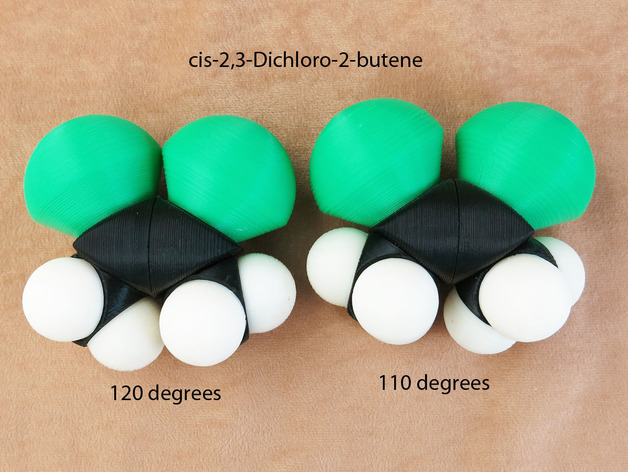
Space-filling molecular models: Carbon expansion set
thingiverse
Carbon generally can make four bonds to other atoms. If there is only one bond to each atom, the carbon resembles a tetrahedron with an atom bound to each face (or vertex, depending on how you're drawing it). If there is a double bond, the atoms generally occupy the same plane and are 120 degrees from one another. If there is a triple bond, the atoms are in a straight line. So here I present the carbon atoms for the multiply bonded atoms. I designed CarbonDB2 for when you have two carbon atoms double-bonded together. When you have a double bond with bulky side groups on the same side as the bond (the "cis" side in chemspeak) sometimes the angle between the singly bonded atoms relaxes, generally to around 110 degrees. In that case use CarbonDBR. If you have carbon double-bonded to any other atom (generally oxygen or nitrogen) use CarbonDB3. It's exactly the same as CarbonDB2, but the edges are relaxed a bit so it looks better (I'm not exactly sure what these atoms actually look like, but I'm pretty sure they don't have edges). Use whichever one you like. You may have noticed for most of the atoms I've provided that you can rotate the atoms about the bond. You can't do that for the double bonded ones though, because they are locked in place (just like real atoms). The rectangular socket is for the double bond, it represents a slightly smaller bond distance than the other two. CarbonTB3 is for triple-bonded carbon. Technically, you can't rotate those either, but since you can only bond them to another carbon or nitrogen, resulting in something completely symmetrical, no one can tell you can't rotate it so I didn't bother locking it. What looks very much like a triple bond though is a cumulative double bond; in that case you have two groups end-to-end locked at right angles. Use CarbonCDB1 for that. "That doesn't sound like something I'll ever have to make" I hear you exclaim. Yes, you may think so, but this is the carbon you use for carbon dioxide; which is symmetrical, and boring. "You should get out more." Yes, my wife says the same thing. On another note, space filling models are based on two measurements; the covalent radius, which is the distance between atoms. and the Van der Waals radius, which gives the diameter of the atom itself. The covalent radii can be calculated quite accurately; the Van der Waals radii are harder. There are several values for the Van der Waals radius for carbon; I use a value of 1.5 Angstroms, which is a little on the small size (some use 1.7). I think it looks better. Perhaps this shouldn't be the first criterion to be considered, but it shouldn't be the last either. As a bonus, this set includes double-bonded oxygen. See the starter set (http://www.thingiverse.com/thing:1720048), halogen expansion set (http://www.thingiverse.com/thing:1730099), and the sulfur and phosphorous expansion set (http://thingaverse.com/thing:2350618) for more useful elements. Print Settings Printer: Da Vinci 1A Rafts: No Supports: Doesn't Matter Resolution: 0.2 mm Infill: 10% Notes: Three perimeters works well
With this file you will be able to print Space-filling molecular models: Carbon expansion set with your 3D printer. Click on the button and save the file on your computer to work, edit or customize your design. You can also find more 3D designs for printers on Space-filling molecular models: Carbon expansion set.
